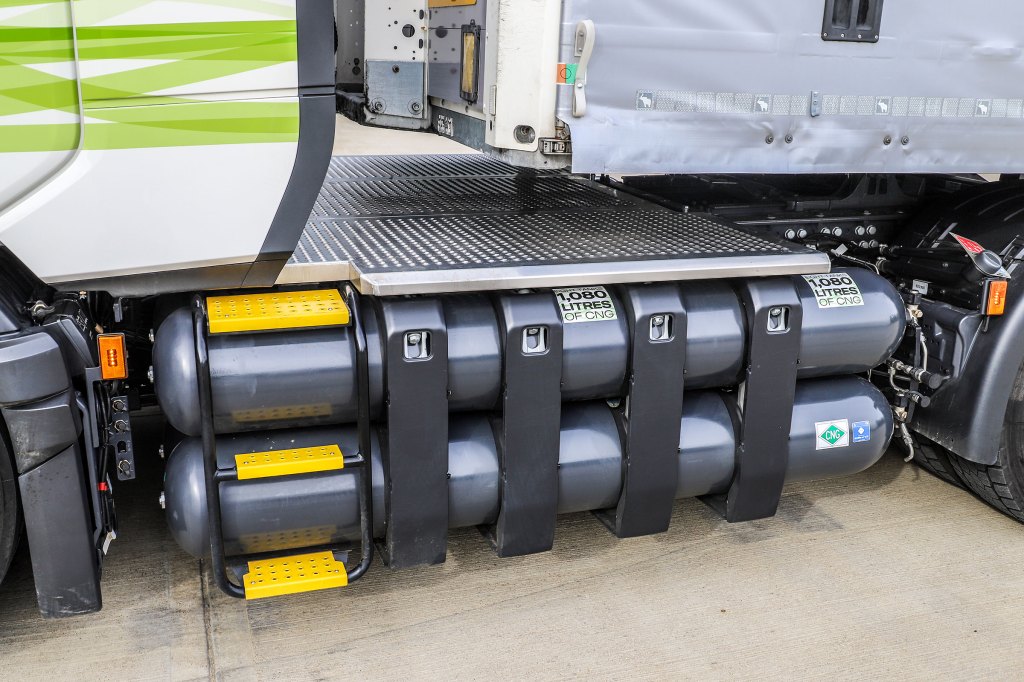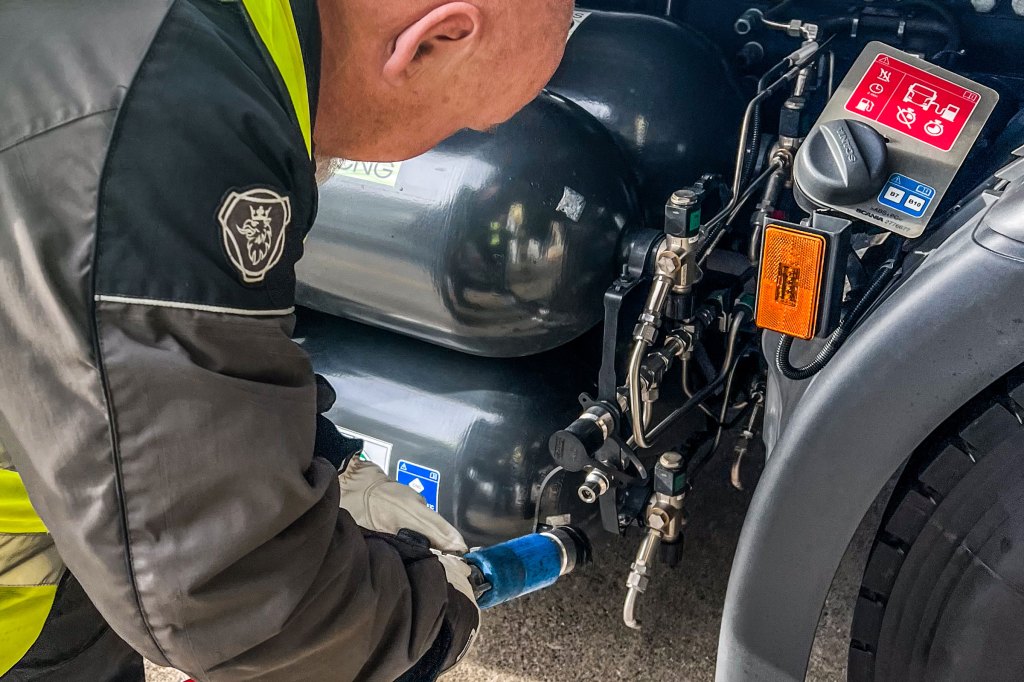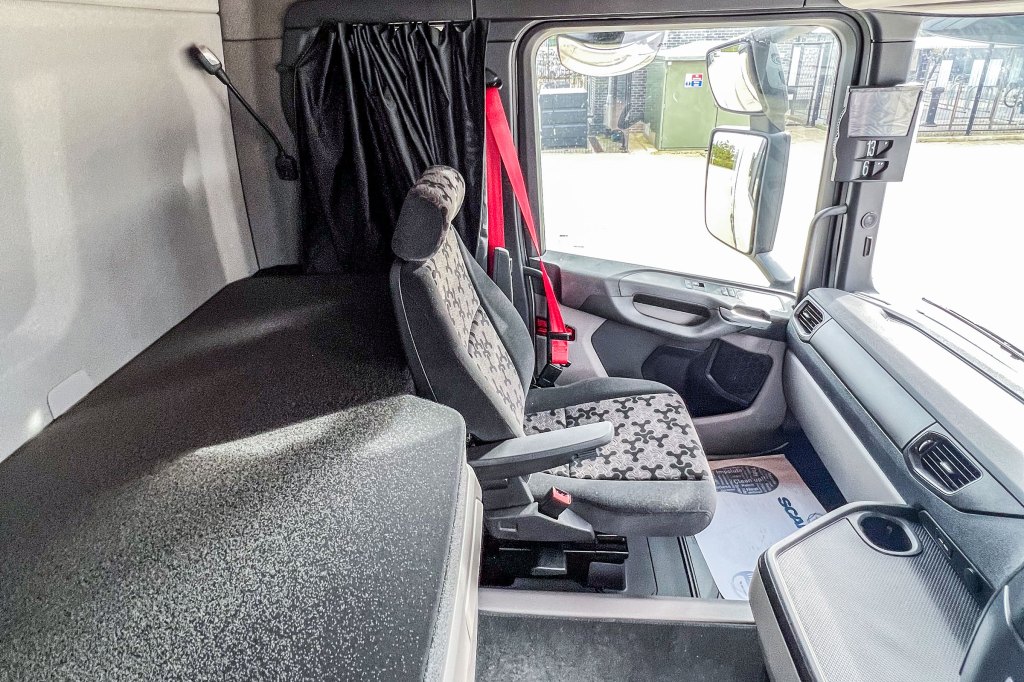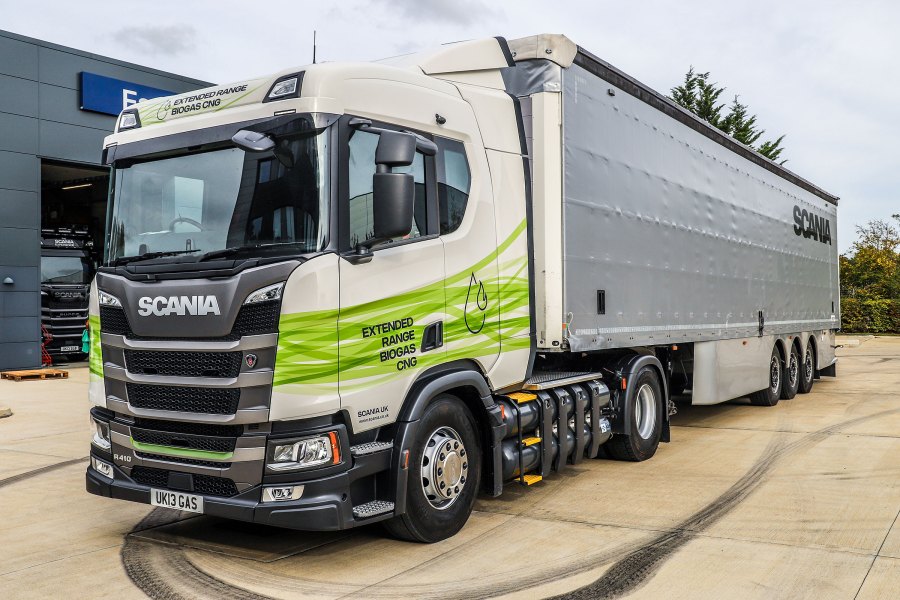Scania is one manufacturer that is promoting gas trucks as a way of reducing emissions. We took a R410 CNG model out for a spin to see if it is a viable alternative to diesel
The world is certainly changing, with an electric truck winning International Truck of the Year, one of four electric vehicles on a shortlist of five. Electric is the buzzword, with ‘long haul’ models from Mercedes and Iveco recently announced alongside those from Scania, Volvo, MAN, Renault, and DAF.
Surely, the world of road haulage is going electric? Well, maybe not. Gas and Hydrogen are realistic alternatives for those who need to be weaned off their faithful diesel engines.
Iveco has mainly promoted gas and now Scania, while Volvo also has gas trucks in its range. Scania recently arranged for me to have a drive in its R410 CNG model and it was too good an offer to turn down.
Technical overview
The R410 was a 4×2, so initially, you might think that it has limited appeal, but in truth, for the market, it is aimed at, perhaps not. Likewise, 410hp is not really enough for most 44-tonne operations, but for 40 tonnes, then it hits the 10hp per tonne sweet spot and so should, theoretically, be similar to a 460R at 44 tonnes.
The truck I drove had the basic sleeper cab, what could be called the ‘flat roof’, but even then, Scanias have a bit of height on them, so it’s not a truly flat roof. But it’s not the Highline. I’ve always liked the R cab and found it deceptively roomy inside compared with other similar trucks in its class.
The engine is the 13-litre OC13-101 rated at 410hp and 2,000Nm, so it doesn’t use the new Super powertrain. Since my drive, Scania has announced biogas versions of that Super driveline, with two engine choices, the OC12-103 at 420hp and the OC13-104 at 460hp.
The R410 was fitted with the GRS905R 12-speed Opticruise automated manual gearbox and the R780 rear axle. The ratio of the rear axle was 1:2.59. The front axle was rated at 8,000kg and the rear drive axle at 11,500kg on a 3,850mm wheelbase. 315/80 R22.5 tyres on steel wheels were fitted throughout. The truck had air suspension on the rear and leaf steel suspension on the front.
The size of the fuel tanks is an important factor for gas trucks, and my test truck had 1,080 litres capacity in total – 472 litres on the right (four 118-litre cylinders) and 608 litres on the left of the chassis (four 152-litre cylinders). This is a big factor as to why so many gas trucks are 4×2, as fitting a third axle seriously diminishes the fuel capacity which naturally affects the range. Small midlifts are an option, but also, it must also be stressed that being only 410hp, going up to 44 tonnes could see the truck start to struggle.
Also, if you have a smaller engine moving more weight, it will use more fuel, further restricting the range. And with the limited gas refuelling infrastructure, that is an issue. However, there are plenty of applications where 40 tonnes on five axles is suitable for many hauliers, and these trucks are especially popular for supermarket work where 40 – and even 35 tonnes on four axles – operation is commonplace.

On the road
The truck arrived back at Scania’s Milton Keynes office with just 10% of its fuel capacity left in the tank, so the first thing was to refuel it. That was 25 miles away at Northampton and I was assured I would have – just – enough fuel to get there. Nevertheless, it was still quite a nervous drive knowing I was also running at a tonne shy of the full GVW of the artic; 40 tonnes.
So I had a lot of weight on board and, I admit it, a bit of range anxiety. That was not helped by the fact that the fuel gauge dropped quickly. The M1 was busy, but flowing nicely, but being so heavy, the R410 took a little while to get up top speed, and many other trucks overtook me. But it soon got to 56mph, and I was then able to do a few overtakes myself.
I admit I was relieved to see my junction and to get to the Red Lion truck stop at Northampton, by which time I had just 2% fuel left in the tanks according to the gauge! The first thing on the agenda was to fill up. This isn’t quite as simple as filling a diesel truck, but it’s still very simple. Let’s face it, it’s a slight change in procedure, and once you’ve got it, you’ve got it!
You turn the pump switch to ‘stop’ and check there is a green light. Then you attach the fuel nozzle to the port on the truck; there are two sizes of hose. Using a keyfob, you record your mileage and then flick the pump from ‘stop’ to ‘start’ which turns the light to red to signify the pump is in use, and then the pump will automatically start the fuelling procedure. It is advisable to supervise this process just in case anything goes wrong, but that is unlikely.
Once the tanks are full, the pump will stop, and the display will show ‘full’. Flick the switch back to ‘stop’, disconnect the nozzle, and return it to its holster. It really is that easy.
The first pump I turned up to, the nozzle wouldn’t connect. That might have been driver error, but as I couldn’t get it to connect, so I switched to a different pump and all was fine, and I got the much-needed fuel in the tank; It didn’t take too long to fill up either – no longer than filling a full tank of diesel. There was obviously nothing wrong with the other nozzle, because a Waitrose Gas Scania P340 pitched up and connected to the pump fine.
Fully fuelled, I could now start to take the truck out for a longer run with less stress! I returned to the M1 and headed up a few junctions before taking the M6 for a junction towards Rugby and then heading to the A5 Watling Street, an old Roman road.
This heads straight back to Milton Keynes via Towcester, but it’s a predominately single-carriageway main road with a good few twists, turns, stops, starts and hills and descents – a perfect playground to give any truck a decent workout and enable me to get a good feel for the lorry and its performance.
As I was fully loaded, I wasn’t expecting a sparking, hill-romping performance, while it took a little bit to get going, once it was up to top speed, the Scania held its performance exceptionally well. Like any Scania, you have to keep an eye on the cruise control speed when going downhill as it has a tendency to run away, but the effective engine brake and concentration means there is no issue for a good driver. But just keep an eye on the speed when loaded and heading downhill

Conclusions
The R410 CNG is actually a two-year-old model, and Scania has just announced gas engines for its 420 and 460 Super models – so it is now offered as the 420P, 420G and 420R and the same with the 460hp engine. That gives Scania a better spread of suitable vehicles available to customers. While my R410 coped well at 40 tonnes, I think more operators would prefer a 460hp model. Also, having seen a gas 410 model with a small midlift axle, it’s fair to assume that would be available as well with the 460, and that could be very appealing, albeit with lower fuel capacity.
I’ve driven lots of New Gen Scanias to know they are, almost without fail, an incredibly enjoyable driving experience and it’s understandable why there are some many of them on the road. The R cab is a superbly laid out place to work for the driver and for the kind of jobs these trucks will do, it’s a veritable palace, I would actually say a G cab is fine for the supermarket and shop distribution work these vehicles might typically find themselves doing. So I don’t need to go into too much detail about that.
The questions that hauliers will have are not actually about the product – we all know Scanias are great trucks – it’s about the cost of operating gas trucks and, most importantly, how do you keep them fuelled and eliminate any range anxiety?
A full tank gives the truck a range of 807km (about 500 miles), which is much better than an electric truck and realistically the top end of a typical day’s work. Fuel savings are typically up to 5% better than diesel, and the fuel is marginally cheaper. The trucks tend to cost about 30-35% more than their diesel counterparts, but the cheaper fuel and better fuel returns should mean that gas truck tends to work out cheaper after the second year of use, and yet they still offer all the performance of a diesel truck.
Currently, there are only about 20 gas stations in the UK that sell CNG, and that means coverage is variable – some areas, like Scotland, are veritable deserts for the gas.
A gas truck just won’t work for general haulage – nationwide coverage with a curtainsider. However, it’s ideal for regular, repeat scheduled ringfenced work. If you could have a gas filling station in your yard, then even better, but so long as there is a gas station on its regular route, then the truck should be fine.
It should appeal to large fleets which can do just that – 40 tonne GVW work on a set route. Yes, a gas truck can be used anywhere but you have to be fully aware of where the gas stations are and be prepared to top up every time you pass one if you do suffer from concerns about running low. Drivers need to buy into them as well be prepared to use the – admittedly very simple – refuelling pumps.
As I mentioned, while we were filling up, a Waitrose Scania P340 pulled in. The driver was happy with it, although he did cite it could use a bit more power (he was running at 35 tonnes maximum), and was very interested to see the R410, and I would suggest the 410 engine would be the best fit even for four-axle 35-tonne work. Now the Super driveline is available as a gas truck, then I think the 460G/R could be the best gas Scania.
The big plus point for gas trucks is that they lower your emissions by some 90%+, which is great for the environment and your customers.
At the moment, they are a better bet than an electric truck on their weight and range, although a 6×2 gas truck might struggle on the range like an electric truck. One question I just can’t answer, however, is what their longevity is likely to be. I can’t see them becoming especially obsolete soon, and gas technology may improve. The big question is, will electric overtake them? And if so, when? Will the infrastructure be there to support them?
It’s fair to say gas trucks are not ideal for all applications, but if you can make one work and tailor it to a specific job, they have a lot going for them.
We like
- Low emissions
- Performance is good
- Scania build quality
- Advantages over electric
We don’t like
- Availability of gas station
- Limited roles the truck can work
Specifications – Scania R410 CNG
- Design GVW: 40 tonnes
- Chassis: 3,850mm wheelbase
- Front axles: 8,000kg
- Rear axle: R780 11,050kg, 1:2.59 ratio
- Gearbox: GRS905R 12-speed automatic
- Engine: OC13 101 13-litre straight six
- Max power: 410hp @ 1,800rpm
- Max torque: 2,000Nm @ 900-1,290rpm
- Cab: R sleeper







